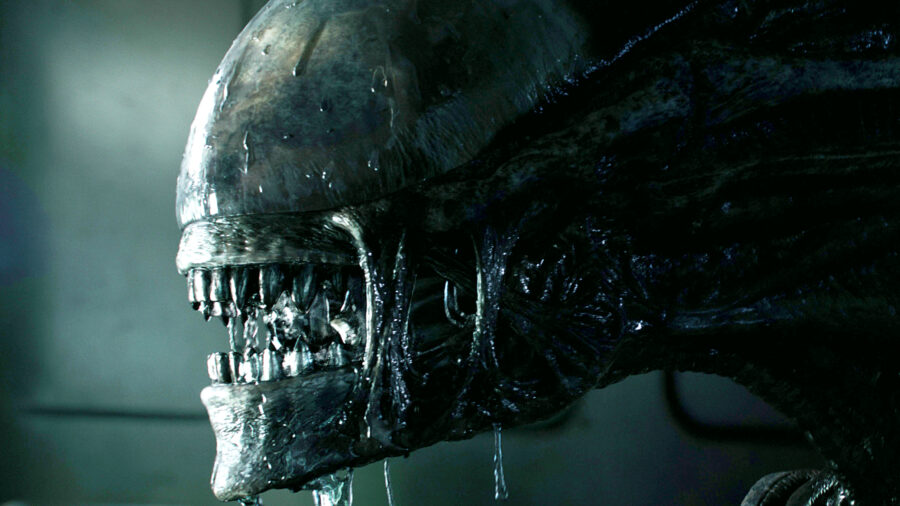The Great Sylvester Stallone Alien Movie You’ll Never See
Here's what you would have seen if Sylvester Stallone had made that Alien movie.
This article is more than 2 years old

It’s just another case of what could have been. Sylvester Stallone, one of the biggest action stars of the ‘80s and ‘90s, was set to pair up with leading lady Kim Basinger, in a film that was billed as Alien on a train.
The movie was, at first, called Dead Reckoning and along with Sylvester Stallone and Kim Basinger, had caught the eye of Ridley Scott, the director who helmed the 1979 sci-fi horror hit, Alien. Not only that, but as Ridley Scott became involved with the project, he reached out to noted artist, the late H.R. Giger, the man who designed the creatures for Ridley Scott’s hit film.
Jim Uhls wrote the script for Dead Reckoning. The story was set in a not-too-distant future where a genetically created creature was loose on a runaway train. In David Hughes’ book, Tales From Development Hell: The Greatest Movies Never Made, Uhls described his vision of the creature. “The creature was a humanoid with a genetically altered brain that was intended to be used as the ‘hard drive’ in an artificial intelligence project.”
See the concept art for the Alien-like movie that should have starred Sylvester Stallone below:
Tentacled beastie created by Rick Baker's creature crew for the unmade future horror movie, Isobar. pic.twitter.com/4dElNkqduY
— Body Snatchers (@BodySnatchers79) August 25, 2020
More concept art by Oliver Scholl and Michael Meier for the unmade sci-fi monster movie, Isobar, a project developed for Sylvester Stallone to star in with Roland Emmerich directing. pic.twitter.com/NlQseLLWNG
— Body Snatchers (@BodySnatchers79) August 25, 2020
Sounds interesting, if not familiar. But what a grouping of talent. Ridley Scott, Sylvester Stallone, and Kim Basinger. It was also said that screen legend Walter Matthau (The Odd Couple, Grumpy Old Men) and Jim Belushi were set to co-star. With all this talent, with Carolco (big at the time) producing along with Joel Silver, how could this potentially hit feature film derail?
Two words: creative differences. As the project moved farther along, those pesky creative differences began to rear their ugly heads. Ridley Scott was the first to leave, though his departure came as a major surprise to H.R. Giger. When Ridley Scott had approached Giger with the film, Scott didn’t have a signed contract. He told Giger just to think about the project to see what he could come up with. In the meantime, Scott would continue negotiations with Carolco.
Giger did what Giger had always done: diving head-first into a project. “If somebody is telling me something I am always so enthusiastic that I don’t wait until the contracts are done, otherwise I will lose interest,” he explains in Hughes’s book via Boing Boing. “I have to do it when I have the spark.” So, for nine months Giger went to work on various designs. The Sylvester Stallone project went from being called Dead Reckoning to The Train, so Giger focused much of his work around crazy-looking trains, train stations, and passenger compartments. Giger even designed a wild emergency exit where passengers were ejected from the non-stopping train into soft foam.
Concept art for Isobar features a bespectacled, Ray Tango-like Stallone in a dystopian city recalling Fritz Lang's Metropolis. However, Isobar was also a "Snowpiercer meets Alien" monster movie. pic.twitter.com/g31XWjdmyj
— Body Snatchers (@BodySnatchers79) August 25, 2020
All the while, Giger was unable to reach Ridley Scott to keep him abreast of his progress. Finally, a frustrated Giger got a call from Scott, who informed him that he had moved on from the project to go direct Thelma & Louise. He told Giger he moved on because he was given too little freedom artistically.
The Sylvester Stallone project then moved from Ridley Scott to Roland Emmerich. It also was given fresh rewrites from noted scribes Dean Devlin, then Steven de Souza, he of Die Hard fame. The movie also changed titles, once again. It was now called ISOBAR.
When de Souza got his hands on the script, it was something he felt he’d seen before. “They wanted a total reinvention of the script,” de Souza says of the newly titled film. “The original script was one of these usual dystopian, post-apocalyptic futures, and the movie was a complete rip-off of Aliens. It was sort of like Aliens combined with Alien, with a squad of guys assigned to catch this monster and bring it in for study by “The Company” — a shameless rip-off.”

De Souza then nit-picked more at the script, eventually saying, “It was too much like Alien, the monster wasn’t fresh enough and there was no explanation of why the world was this way — it was one of these science fiction movies where it’s supposed to be the near-future, but it’s a completely implausible near-future without any kind of explanation.” He then concluded, “The script was just embarrassing.”
Despite its embarrassing features, de Souza went to work and finished the Sylvester Stallone project. This is where Devlin pops in with his take on de Souza’s finished product. “I think the biggest change which Steven made in his draft, which we didn’t do, is that he gave it a kind of uplifting feeling at the end, a kind of E.T. thing. And also Steven came up with some amazing characters that weren’t in the original drafts. That’s really the direction he went — it just wasn’t what we were going for. We were going for something much more like Alien.”
Creative differences. Seems like they weren’t reserved just for Scott. The whole production sounds like it was filled with them.

With no one being able to settle on the tone of the script, production wasn’t looking promising anymore. They also couldn’t come to terms with the look of the monster, so with a bloated budget of $90 million on the line, the project fell apart.
Sylvester Stallone and Kim Basinger would eventually get to work together. Unfortunately, it was on the at times hard-to-watch feature, Grudge Match, which pitted Stallone versus Robert DeNiro in a boxing match that should have taken place in the early ‘90s, and also starred Kevin Hart.

Alien on a train. The premise sounds interesting. The cast that was set to roll also sounds interesting. Development Hell can literally be, well, hell for many Hollywood projects but in this case, perhaps they did all involved a favor.
This wouldn’t bode well for the future of Carolco. Failing to produce Dead Reckoning aka The Train aka ISOBAR would be their death knell as it led them to other failed projects such as the never-produced Arnold Schwarzenegger medieval story, Crusade. The production company would be bankrupt and disappear by 1995. Oh, what could have been.












